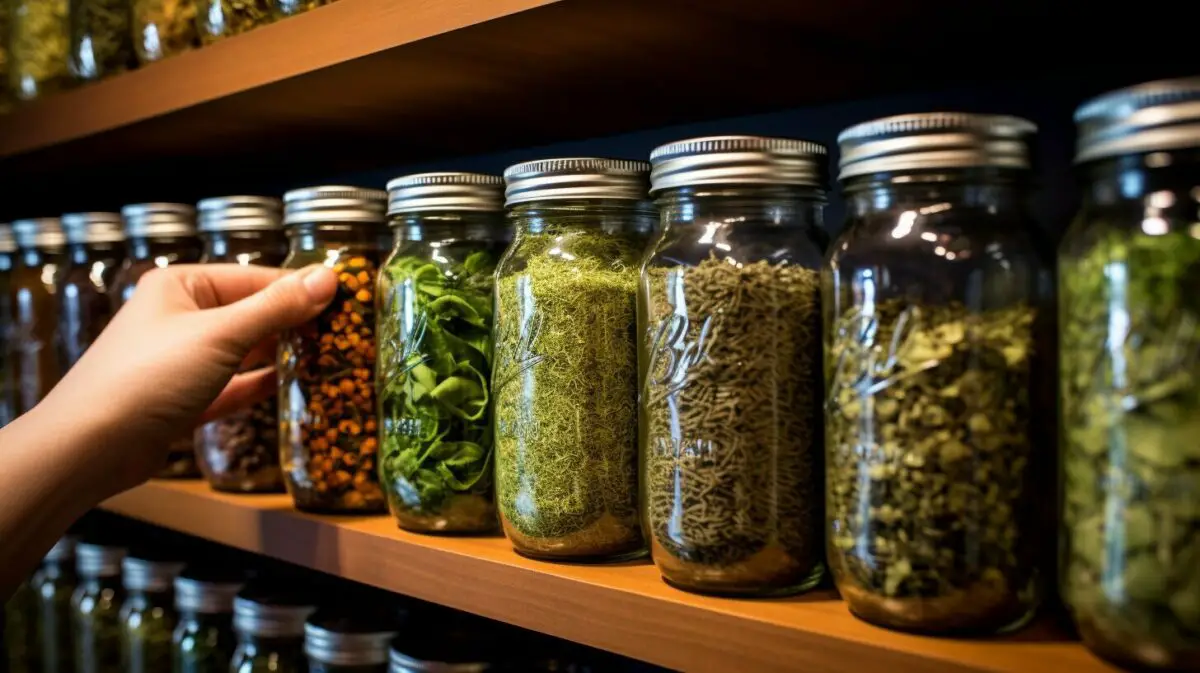How to Store Parsley
Storing parsley correctly is crucial to maintain its freshness and vibrant flavor. Whether you’re a culinary enthusiast or simply enjoy adding parsley to your dishes, knowing how to store this herb properly will ensure you have fresh parsley on hand whenever you need it.
There are several methods you can use to store parsley and keep it fresh for longer periods. One method is to use a large canning jar or herb saver. Simply add a few inches of water to the jar and place the cut sides of the parsley into the water before capping it with a lid. This method helps to maintain the herb’s moisture and preserve its flavor.
Another effective way to store parsley is to place it in a glass jar partially filled with water. Loosely cover the jar with a plastic bag to create a humid environment, then store it in the refrigerator. This method helps to prevent wilting and browning of the parsley leaves.
If you prefer to store parsley without water, you can wrap it in a dry kitchen towel and place it in a ziplock bag in the refrigerator. Alternatively, you can wrap the parsley in a damp kitchen towel before storing it in the same way. Both methods help to retain the herb’s moisture without the need for water.
To store parsley without any additional wrapping, you can simply place it in a plastic bag in the refrigerator. It’s important not to wash or dry the parsley before storing it this way, as excess moisture can cause the herb to spoil more quickly.
If you want to extend the shelf life of parsley even further, freezing is an excellent option. Start by washing and drying the parsley thoroughly. You can then choose to either roll it into a stick and store it in a ziplock bag or chop it and mix it with oil before spooning it into ice cube trays and freezing. Frozen parsley can be easily added to soups, stews, and other dishes whenever you need it.
How to Store Parsley – Key Takeaways:
- Storing parsley correctly ensures its freshness and vibrant flavor.
- Methods include using a canning jar, glass jar with water, or ziplock bag in the refrigerator.
- Wrapping parsley in a damp or dry kitchen towel can also help maintain its moisture.
- Parsley can be frozen for extended shelf life and easy future use.
- Choose the storage method that best suits your needs and culinary preferences.
Why Proper Parsley Storage Matters – How to Store Parsley:
Proper parsley storage is essential to maximize its shelf life, maintain its freshness, and preserve its flavor, aroma, texture, color, and nutrition. By storing parsley correctly, you can ensure that it remains vibrant and full of flavor for longer periods, allowing you to enjoy its culinary and nutritional benefits to the fullest.
When parsley is not stored properly, its shelf life can be significantly reduced. Improper storage can lead to wilting, loss of flavor, and even spoilage. Additionally, parsley that is poorly stored may lose its vibrant green color and crisp texture, making it less visually appealing and less enjoyable to eat. How to Store Parsley.
Storing parsley in the right conditions can help preserve its natural oils, which contribute to its distinct aroma and taste. It’s these oils that give parsley its unique flavor profile and make it a sought-after herb in the culinary world. By storing parsley correctly, you can ensure that these oils are preserved, enhancing the overall taste and aroma of your dishes.
Parsley is not just a flavorful herb; it is also packed with essential nutrients. It is a rich source of vitamin K, which plays a vital role in blood clotting and bone health. Additionally, parsley is loaded with antioxidants that help protect the body against oxidative stress and inflammation. By storing parsley properly, you can help retain these valuable nutrients, ensuring that you reap the nutritional benefits when adding it to your meals.
| Parsley Storage Tips – How to Store Parsley |
|---|
| Store parsley in a large canning jar or herb saver, adding a few inches of water and placing the cut sides of the parsley into the water before capping it with a lid. |
| Put parsley in a glass jar partially filled with water and cover it loosely with a plastic bag before storing it in the refrigerator. |
| Wrap parsley in a dry kitchen towel and place it in a ziplock bag in the fridge, or wrap it in a damp kitchen towel and store it in the same way. |
| Store parsley in a plastic bag in the refrigerator without washing or drying it. |
| Freeze parsley by washing and drying it, rolling it into a stick, and storing it in a ziplock bag, or chopping it and mixing it with oil before spooning it into ice cube trays and freezing. |
By following these storage tips, you can ensure that your parsley stays fresh, flavorful, and nutritious. Experiment with different methods to find the one that works best for you and enjoy the benefits of having a stash of fresh parsley on hand whenever you need it.

“Proper parsley storage is the key to ensuring that this versatile herb remains at its best, both in terms of flavor and nutritional value.” – [Your Name]
Storing Parsley in the Refrigerator
The refrigerator can be a great place to store parsley, keeping it fresh and ready to use in your culinary creations. There are several methods you can try to maximize the shelf life of your parsley in the refrigerator.
One method is to use a large canning jar or herb saver. Simply add a few inches of water to the jar and place the cut sides of the parsley into the water. Then, cap it with a lid to create a mini greenhouse effect that helps maintain the herb’s freshness. This method is particularly effective for preserving parsley bundles with stems.
Another simple method is to put the parsley in a glass jar partially filled with water. Cover the jar loosely with a plastic bag before storing it in the refrigerator. This helps maintain the moisture levels around the herb while preventing direct contact with the bag, which could cause condensation and spoilage.
If you prefer a more sustainable option, you can wrap parsley in a dry kitchen towel and place it in a ziplock bag in the refrigerator. Alternatively, you can wrap the parsley in a slightly dampened kitchen towel before storing it in the same way. Both methods help protect the herb from excess moisture, which can lead to wilting.
Table 1: Refrigerator Storage Methods for Parsley
| Method | Description |
|---|---|
| Canning Jar or Herb Saver | Store parsley bundles in a jar with water to maintain freshness. |
| Glass Jar and Plastic Bag | Partially fill a jar with water, cover with a bag, and refrigerate. |
| Ziplock Bag with Dry Kitchen Towel | Wrap parsley in a dry towel and store it in a bag in the fridge. |
| Ziplock Bag with Damp Kitchen Towel | Wrap parsley in a slightly moistened towel, then refrigerate. |
Another convenient option is storing parsley in a plastic bag in the refrigerator without washing or drying it. This method is ideal when you’re short on time or don’t have access to other storage containers. Remember to seal the bag tightly to prevent moisture loss and cross-contamination with other foods.
Lastly, if you have an abundance of parsley and want to prolong its shelf life, you can freeze it. Start by washing and drying the parsley thoroughly. Then, you have two freezing options:
- Roll the parsley into a stick, place it in a ziplock bag, and seal tightly. This method is great for portioning the herb according to your needs.
- Chop the parsley and mix it with oil before spooning it into ice cube trays and freezing. This allows you to have ready-to-use portions of parsley that can be easily added to your recipes.

Experiment with these different parsley storage methods to find the one that suits your needs and kitchen setup. By storing parsley properly in the refrigerator, you can ensure its freshness and vibrant flavor are preserved, enhancing your culinary creations.
Storing Parsley at Room Temperature
If you prefer storing parsley outside of the refrigerator, room temperature storage can be a suitable choice. To keep your parsley fresh and vibrant, there are a few simple steps you can follow.
First, gather your parsley bundles, making sure to remove any damaged or wilted leaves. Next, gently rinse the parsley under cold water to remove any dirt or debris. Pat it dry with a clean kitchen towel or paper towels.
Once your parsley is dry, you have a few options for storing it at room temperature. One method is to place the parsley stems in a glass jar partially filled with water. Cover the jar loosely with a plastic bag to help retain moisture. This setup allows the parsley to absorb water and stay hydrated while still being exposed to air, which prevents wilting.
Another option is to wrap your parsley in a damp kitchen towel, then place it in a ziplock bag or airtight container. The moisture from the towel will help keep the parsley fresh, while the container will protect it from air exposure. Remember to check the towel periodically and rewet it if needed to maintain the desired level of moisture.
Benefits of Room Temperature Storage
Storing parsley at room temperature offers several advantages. Firstly, it allows the herb to maintain its texture, as exposure to cold temperatures can cause parsley leaves to become limp and lose their crispness. Additionally, room temperature storage can enhance the flavor and aroma of parsley, making it a great option for those who value the herb’s delicate taste and fragrance.
By following these simple steps, you can ensure your parsley stays fresh and flavorful at room temperature. Whether you choose to store it in a jar with water or wrapped in a damp towel, room temperature storage offers a convenient and effective way to preserve this versatile herb.
| Pros | Cons |
|---|---|
| – Maintains parsley’s texture | – Requires regular monitoring and rewetting of the towel |
| – Enhances parsley’s flavor and aroma | – Limited shelf life compared to refrigeration or freezing |
| – Convenient and easily accessible | – Potential exposure to pests if not stored properly |

The pantry can be a convenient spot for parsley storage, ensuring it stays fresh and accessible. While refrigerating parsley is a popular option, storing it in the pantry can also yield excellent results. To keep your parsley bundles fresh in the pantry, follow these simple steps:
- Start by trimming the ends of the parsley stems to remove any damaged or wilted leaves.
- Fill a glass jar or a vase partially with water, making sure it’s not too full.
- Place the trimmed parsley bundles in the jar, ensuring the cut ends are submerged in the water.
- Loosely cover the jar with a plastic bag, allowing some airflow while protecting the parsley from dust.
- Store the jar in a cool and dry spot in your pantry, away from direct sunlight and heat sources.
This method provides the parsley with the moisture it needs to stay fresh while maintaining optimal airflow. Make sure to check the water level regularly and change it every few days to prevent it from becoming stagnant.

By storing your parsley in the pantry using this simple method, you can enjoy fresh herbs whenever you need them for your culinary adventures. Remember, fresh parsley not only adds a vibrant flavor to your dishes but also offers a myriad of health benefits.
Did You Know?
“Proper parsley storage is crucial for maintaining its vibrant green color and intense flavor, which can enhance the taste and appearance of your dishes.”
Using Containers for Parsley Storage
Choosing the right container is crucial for maintaining the freshness and quality of stored parsley. Whether you prefer glass jars, plastic bags, or herb savers, each option has its advantages and considerations.
A large canning jar or herb saver is an excellent choice if you want to prolong the lifespan of your parsley. Simply add a few inches of water to the jar or herb saver and place the cut sides of the parsley into the water. This helps keep the parsley hydrated and prevents wilting. Secure the lid tightly to maintain freshness.
If you opt for glass jars, you can partially fill them with water and place the parsley inside. Loosely cover the jar with a plastic bag to create a microclimate that helps retain moisture and prevents the parsley from drying out. This method is ideal for short-term storage in the refrigerator.
For a simple and convenient solution, wrap the parsley in a dry kitchen towel and place it in a ziplock bag before storing it in the refrigerator. The towel helps absorb excess moisture, preventing the parsley from becoming soggy. Alternatively, if you prefer to keep the parsley slightly moist, wrap it in a damp kitchen towel before placing it in a ziplock bag.
| Container | Advantages | Considerations |
|---|---|---|
| Glass Jars | – Help retain moisture – Prevent wilting – Keep parsley fresh | – Limited lifespan – Requires refrigerator storage |
| Plastic Bags | – Convenient and easy to use – Preserve freshness | – May cause condensation – Limited shelf life |
| Herb Savers | – Extend the lifespan of parsley – Maintain optimal moisture levels | – Requires extra storage space – Higher cost |
Tip: Cleaning Containers
- It’s important to clean your chosen storage containers thoroughly before using them to store parsley. Wash glass jars or herb savers with warm water and mild dish soap, ensuring there are no traces of food or grease.
- If using plastic bags, choose high-quality, food-grade bags that are free from any residue or contaminants.
- Properly drying the containers is essential to prevent mold growth or water accumulation that can compromise the freshness of the parsley.
Remember, the key to successful parsley storage lies in selecting the right container and preserving its freshness by maintaining optimal moisture levels.
Experiment with different storage methods to find the one that works best for you. By following these tips, you can ensure your parsley stays fresh and flavorful, ready to enhance a variety of dishes in your culinary adventures.

Properly preparing parsley for storage is an important step to ensure its longevity and quality. Before storing parsley, it is essential to wash and dry it thoroughly. Start by removing any yellow or wilted leaves and separating the parsley into manageable bundles.
One method I recommend is to wash the parsley under cool running water, gently rubbing the leaves to remove any dirt or debris. Once clean, allow the parsley to air dry on a clean kitchen towel or paper towel. Alternatively, you can use a salad spinner to remove excess moisture.
After drying the parsley, you have several options for storage. For short-term storage, wrap the parsley in a dry kitchen towel and place it in a ziplock bag in the refrigerator. This method helps retain moisture and keeps the parsley fresh for up to a week. For longer-term storage, you can also freeze parsley by chopping it finely, mixing it with a little oil, and spooning it into ice cube trays. Once frozen, transfer the parsley cubes into a ziplock bag for easy access.
Remember, properly preparing parsley for storage ensures that it retains its vibrant color, crisp texture, and flavorful aroma. By following these simple steps, you can enjoy fresh and aromatic parsley all year round!

- Wash the parsley under cool running water, gently rubbing the leaves to remove any dirt or debris.
- Allow the parsley to air dry or use a salad spinner to remove excess moisture.
- For short-term storage, wrap the parsley in a dry kitchen towel and place it in a ziplock bag in the refrigerator.
- For longer-term storage, chop the parsley finely, mix it with oil, and freeze in ice cube trays.
Freezing Parsley for Extended Storage
Freezing parsley is an excellent option for long-term storage, allowing you to enjoy fresh parsley flavor all year round. This method helps preserve the vibrant color, aromatic scent, and delicate texture of parsley, making it a versatile herb to have on hand for various dishes. Here are a few simple steps to freeze parsley effectively:
- Washing and Drying: Start by washing the parsley under cold running water to remove any dirt or impurities. Gently pat it dry using a clean kitchen towel or paper towels. Ensuring the parsley is completely dry is crucial to prevent the formation of ice crystals during freezing.
- Storing in Bundles: One method is to roll the parsley into convenient-sized bundles. Secure the bundles with kitchen twine or rubber bands. This approach allows you to easily grab the desired amount of parsley without defrosting the entire batch.
- Ziplock Bag: Place the parsley bundles in a ziplock bag, ensuring to remove as much air as possible before sealing it. Label the bag with the date to keep track of its freshness.
- Chopped with Oil: Another option is to chop the parsley finely and mix it with a little olive oil to prevent it from clumping together. Spoon the mixture into ice cube trays and freeze until solid. Once frozen, transfer the cubes into a resealable bag for easy portioning.
When using frozen parsley, you can add it directly to your culinary creations without thawing. It works well in soups, stews, sauces, marinades, and even in refreshing smoothies or juices. Freezing parsley is a simple and convenient way to ensure you always have this flavorful herb readily available for your cooking endeavors.
Table: Pros and Cons of Freezing Parsley
| Pros | Cons |
|---|---|
| Preserves freshness and flavor | Loss of some texture |
| Convenient and easily accessible | Requires freezer space |
| Allows year-round use | May not be as visually appealing after thawing |
| Reduces waste by prolonging shelf life | May not be suitable for using as a garnish |

By following these freezing methods, you can enjoy the wonderful taste and aroma of parsley in your dishes even when it’s out of season. Whether you choose to freeze parsley in bundles or as chopped cubes, it’s an excellent way to extend the shelf life of this versatile herb. Experiment with frozen parsley in your favorite recipes and elevate the flavors to new heights!
Advantages and Disadvantages of Different Parsley Storage Methods
Each parsley storage method has its own benefits and drawbacks, and understanding them can help you make an informed decision.
Let’s start with storing parsley in a large canning jar or herb saver with water. This method keeps the parsley hydrated, maintaining its freshness and crispness for longer periods. The water acts as a barrier, preventing the herb from drying out. However, it requires a larger storage space and can be cumbersome to handle.
Another popular method is storing parsley in a glass jar with water and loosely covering it with a plastic bag before refrigeration. This technique creates a controlled environment, extending the shelf life of the herb. The glass jar provides stability, while the plastic bag allows for proper air circulation. However, the plastic bag may limit visibility and create condensation, affecting the overall quality of the parsley.
| Storage Method | Advantages | Disadvantages |
|---|---|---|
| Glass jar with water and plastic bag | Extended shelf life, controlled environment | Reduced visibility, potential condensation |
| Dry kitchen towel in a ziplock bag | Convenient, preserves freshness | Limited hydration, risk of wilting |
| Damp kitchen towel in a ziplock bag | Retains moisture, maintains crispness | Potential mold growth, short shelf life |
| Plastic bag without washing or drying | No additional steps required | Potential wilting and spoilage, limited freshness |
| Freezing in ziplock bag or ice cube trays | Long-term storage, preserves flavor and aroma | Change in texture, potential loss of nutritional value |
| Not washing or drying, storing in a cool, dark place | Minimal preparation | Short shelf life, potential spoilage |
To maintain parsley’s crispness with convenience, you can wrap it in a dry kitchen towel and store it in a ziplock bag in the refrigerator. This method allows for easy access while preserving the herb’s freshness. However, the lack of moisture may lead to wilting, so it’s important to monitor its condition regularly.
If you prefer a slightly longer shelf life, try wrapping parsley in a damp kitchen towel before placing it in a ziplock bag. The added moisture helps maintain crispness, but it also creates an environment conducive to mold growth. Therefore, it’s essential to check the herb regularly for any signs of spoilage.
For a simple and no-fuss approach, you can store parsley in a plastic bag without washing or drying it. This method requires minimal preparation, but be aware that the herb may wilt and spoil quicker compared to other storage methods.
Lastly, if you want to extend parsley’s shelf life significantly, freezing is an option. You can wash and dry the herb, roll it tightly into a stick, and store it in a ziplock bag. Alternatively, chop the parsley, mix it with oil, and spoon it into ice cube trays before freezing. While freezing preserves flavor and aroma, it can alter the herb’s texture and potentially diminish its nutritional value.

Harnessing the Health Benefits of Parsley
In addition to its culinary uses, parsley offers an array of health benefits, making it a valuable addition to your diet. This vibrant green herb is packed with essential vitamins and antioxidants, promoting overall well-being and supporting various bodily functions.
One of the standout benefits of parsley is its high vitamin K content. Just one sprig of parsley contains more than 150% of the recommended daily intake of vitamin K, which plays a crucial role in blood clotting and bone health. Including parsley in your meals can help maintain strong and healthy bones, reducing the risk of fractures and osteoporosis.
Furthermore, parsley is rich in antioxidants, which help protect your body against oxidative stress and inflammation. These antioxidants, such as apigenin and luteolin, have been studied for their potential anticancer properties and ability to mitigate the damaging effects of free radicals in the body. Incorporating parsley into your diet can support a healthy immune system and reduce the risk of chronic diseases.
| Vitamin K | Antioxidants | Anti-inflammatory | Digestive Health |
|---|---|---|---|
| Supports blood clotting and bone health | Protects against oxidative stress and inflammation | May have potential anticancer properties | Aids digestion and relieves bloating |
In addition to its nutritional benefits, parsley is known to support digestive health. Its natural enzymes can aid in digestion, reducing bloating and promoting a healthy gut. Whether sprinkled on top of your favorite dish or blended into a refreshing smoothie, parsley can be a flavorful and nutritious addition to any meal.

With its impressive nutritional profile and versatile culinary uses, parsley is a herb that should not be overlooked. Incorporate this powerhouse herb into your meals to not only enhance the flavor but also reap the numerous health benefits it has to offer.
Exciting Parsley Recipes
Get inspired by these mouthwatering parsley recipes that showcase the herb’s unique flavor and versatility. From refreshing salads to savory soups and zesty dressings, parsley adds a vibrant touch to any dish. Try these delicious recipes and elevate your culinary creations!
Parsley Pesto

For a twist on traditional pesto, whip up a batch of parsley pesto. In a food processor, blend together fresh parsley leaves, garlic, pine nuts, Parmesan cheese, lemon juice, and olive oil until smooth. This vibrant and herbaceous pesto is perfect for tossing with pasta, spreading on sandwiches, or drizzling over grilled meats and vegetables.
Parsley Salad
Light and refreshing, a parsley salad is a wonderful way to showcase the herb’s bright flavor. Combine chopped fresh parsley with diced tomatoes, cucumbers, red onions, and feta cheese. Dress the salad with a simple vinaigrette made from olive oil, lemon juice, Dijon mustard, and a touch of honey. This vibrant salad is a perfect side dish for any meal.
Parsley Soup
Warm up with a comforting bowl of parsley soup. In a large pot, sauté onions and garlic until fragrant. Add chopped carrots, potatoes, vegetable broth, and a generous amount of chopped parsley. Simmer until the vegetables are tender, then blend the soup until smooth. Season with salt, pepper, and a squeeze of lemon juice for an extra burst of flavor.
Parsley Sauce
Bring a burst of freshness to your favorite dishes with parsley sauce. In a blender, combine fresh parsley, garlic, lemon juice, capers, and olive oil. Blend until smooth and creamy. This versatile sauce pairs well with grilled fish, roasted vegetables, or as a dipping sauce for crunchy breadsticks. It’s a delicious way to enhance any meal!
These parsley recipes are just a taste of the many ways to incorporate this versatile herb into your cooking. Whether you’re looking for a zesty dressing, a vibrant salad, a comforting soup, or a flavorful sauce, parsley adds a delightful touch to any dish. Enjoy the unique flavor and versatility of parsley in these mouthwatering recipes!
Parsley Tips and Tricks
Discover some handy tips and tricks that will make working with parsley a breeze. Whether you’re an experienced chef or just starting out in the kitchen, these techniques will help you get the most out of this versatile herb.
1. Storing Parsley
Properly storing parsley is crucial to maintaining its freshness and flavor. One method is to use a large canning jar or herb saver, adding a few inches of water and placing the cut sides of the parsley into the water before capping it with a lid. This helps to keep the parsley hydrated, preventing wilting and extending its shelf life.
| Storing Method | Description |
|---|---|
| Glass Jar with Water | Put the parsley in a glass jar partially filled with water and cover it loosely with a plastic bag before storing it in the refrigerator. |
| Damp Kitchen Towel | Wrap the parsley in a damp kitchen towel and store it in a ziplock bag in the refrigerator. |
| Dry Kitchen Towel | Wrap the parsley in a dry kitchen towel and place it in a ziplock bag in the refrigerator. |
| Plastic Bag | Store parsley in a plastic bag in the refrigerator without washing or drying it. |
Choose the method that works best for you and enjoy fresh parsley whenever you need it.
2. Freezing Parsley
If you have an abundance of parsley and want to preserve it for later use, freezing is a great option. Start by washing and drying the parsley thoroughly. Then, you can either roll it into a stick and store it in a ziplock bag or chop it and mix it with oil before spooning it into ice cube trays and freezing. This way, you’ll have ready-to-use parsley whenever you need it without wasting any.
3. Enhancing Flavor
Parsley can add a burst of freshness and flavor to your dishes. To enhance its flavor, consider blanching the parsley briefly in boiling water for a few seconds, then immediately transferring it to an ice bath. This simple technique helps to preserve the vibrant green color and intensify the taste of parsley.
Now that you’re equipped with these parsley tips and tricks, you can confidently incorporate this herb into your culinary repertoire. Enjoy the freshness and versatility of parsley in your dishes!

By following the techniques and tips outlined in this article, you’ll be able to achieve perfect parsley storage every time. Whether you choose to store it in the refrigerator, at room temperature, or in the pantry, there are various methods that can help preserve the freshness, flavor, and nutritional benefits of parsley.
One method is to use a large canning jar or herb saver, adding a few inches of water and placing the cut sides of the parsley into the water before capping it with a lid. This helps to keep the parsley hydrated and prevents wilting. Alternatively, you can put the parsley in a glass jar partially filled with water and cover it loosely with a plastic bag before storing it in the refrigerator. This method also helps to maintain the moisture content of the parsley.
If you prefer to store parsley in the refrigerator without using water, you can wrap it in a dry kitchen towel and place it in a ziplock bag. This method helps to absorb excess moisture and prevents the parsley from becoming soggy. Another option is to wrap the parsley in a damp kitchen towel before storing it in the same way. This method provides a humid environment that helps to keep the parsley fresh.
For those who want to extend the shelf life of parsley, freezing is a great option. After washing and drying the parsley, you can roll it into a stick and store it in a ziplock bag. Alternatively, you can chop the parsley, mix it with oil, and spoon it into ice cube trays before freezing. These frozen parsley cubes can be easily added to soups, stews, and other dishes whenever needed.

Remember, proper parsley storage not only ensures its longevity but also helps to preserve its vibrant color, fresh aroma, and nutritional value. So, make use of the tips and methods shared in this article to enjoy the goodness of parsley in your culinary creations for longer periods.
Additional Keywords
Explore an array of exciting parsley applications, from traditional garnishes to innovative dishes and beverages. Parsley’s vibrant flavor and versatility make it a perfect ingredient to elevate any meal. Whether you’re looking to add a pop of freshness to a salad or create a flavorful marinade, parsley has got you covered. Let’s dive into some enticing parsley recipes and discover how this herb can enhance your culinary experience.
Parsley Garnish
A simple sprinkle of chopped parsley can transform any dish into an eye-catching masterpiece. Add a vibrant touch to your entrees, appetizers, or side dishes by garnishing them with a sprinkle of fresh parsley. Its bright green color and mild flavor provide the perfect finishing touch.
Parsley-infused Dishes
Take your taste buds on an adventure with parsley-infused dishes. Create a delightful parsley pesto by blending parsley, garlic, pine nuts, Parmesan cheese, and olive oil. Use this flavorful pesto as a pasta sauce, dip, or spread. Experiment with parsley in salads, soups, and sauces to elevate the flavors and add a refreshing twist.
Parsley in Beverages
Don’t limit parsley to just food! This versatile herb can also be an exciting addition to your beverages. Blend parsley with fruits, vegetables, and a dash of lemon juice to create a refreshing smoothie. Infuse your water or tea with a few sprigs of parsley for a hint of herbal goodness. Get creative and try adding parsley to your cocktails for a unique flavor profile.
Parsley in Desserts
Yes, you read that right! Parsley can even be used in desserts to create innovative flavor combinations. Whip up a parsley-infused cake or cookies and experience the delightful balance of sweet and herbaceous notes. Try using parsley in granola or jams to add a surprising twist to your breakfast routine. The possibilities are endless when it comes to incorporating parsley into your sweet treats.
So, next time you have some fresh parsley on hand, think beyond the traditional garnish. Let your creativity shine and explore the wide range of tantalizing parsley applications. From inventive recipes to unique beverages, parsley is a culinary superstar that can elevate your dishes to new heights.
How to Store Parsley – FAQ:
Q: How should I store parsley to keep it fresh?
A: There are several methods you can use to store parsley and keep it fresh. One way is to place the cut sides of the parsley into a large canning jar or herb saver with a few inches of water, and then cap it with a lid. Another method is to place the parsley in a glass jar partially filled with water, cover it loosely with a plastic bag, and store it in the refrigerator. Alternatively, you can wrap parsley in a dry kitchen towel and place it in a ziplock bag in the fridge, or wrap it in a damp kitchen towel and store it in the same way. You can also store parsley in a plastic bag in the refrigerator without washing or drying it. Lastly, parsley can be frozen by washing and drying it, rolling it into a stick and storing it in a ziplock bag, or chopping it and mixing it with oil before spooning it into ice cube trays and freezing.
Q: Why is proper parsley storage important?
A: Proper parsley storage is important because it helps to preserve the freshness, flavor, and nutritional benefits of the herb. By storing parsley correctly, you can extend its shelf life and ensure that it remains vibrant, aromatic, and full of nutrients for longer periods.
Q: How can I store parsley in the refrigerator?
A: To store parsley in the refrigerator, you can use a few different methods. One option is to place the parsley in the produce drawer, either in a plastic bag or wrapped in a damp kitchen towel. Another method is to store the parsley in a glass jar partially filled with water, covering it loosely with a plastic bag. You can also wrap the parsley in a dry kitchen towel and store it in a ziplock bag in the fridge. Ensure that the parsley is properly sealed to prevent moisture loss and maintain its freshness.
Q: Can I store parsley at room temperature?
A: Yes, you can store parsley at room temperature, but it is best to do so for short periods. To store parsley at room temperature, bundle the stems together, trim the ends, and place them in a glass with a small amount of water. Cover the parsley loosely with a plastic bag to prevent wilting. Remember that parsley stored at room temperature may wilt more quickly than when stored in the refrigerator.
Q: Is it possible to store parsley in the pantry?
A: While parsley is typically stored in the refrigerator, you can store it in the pantry under certain conditions. Place the parsley stems in a jar with a small amount of water, similar to storing parsley at room temperature. Ensure that the jar is stored in a cool, dark area away from direct sunlight, heat, and humidity. Proper storage containers will help preserve parsley’s freshness in the pantry.
Q: What types of containers can I use for parsley storage?
A: There are different types of containers you can use for parsley storage, depending on your preference and convenience. Glass jars, plastic bags, and herb savers are commonly used options. Glass jars, partially filled with water and covered with a plastic bag, are great for storing parsley in the refrigerator. Plastic bags are convenient for storing parsley in the fridge without washing or drying it. Herb savers are specifically designed containers that help preserve the freshness of herbs like parsley.
Q: How should I prepare parsley before storing it?
A: Before storing parsley, it is important to prepare it properly. Start by washing the parsley under cold running water to remove any dirt or debris. Gently pat it dry with a paper towel or spin it in a salad spinner to remove excess moisture. To store parsley, you can either bundle the stems together, trim the ends, and place it in a jar with a small amount of water, or wrap it in a kitchen towel and store it in a sealed bag or container.
Q: Can I freeze parsley for long-term storage?
A: Yes, freezing parsley is a great way to store it for an extended period. To freeze parsley, start by washing and drying it thoroughly. You can then roll the parsley into a stick and store it in a ziplock bag, or chop it and mix it with oil before spooning it into ice cube trays and freezing. Frozen parsley can be used in cooking just like fresh parsley, although the texture may slightly change.
Q: What are the advantages and disadvantages of different parsley storage methods?
A: The advantages of storing parsley in a canning jar or herb saver with water are that it keeps the parsley hydrated and maintains its freshness longer. Storing parsley in a glass jar with water in the refrigerator allows for easy access and keeps the parsley from wilting quickly. Storing parsley in a dry kitchen towel and a ziplock bag or a damp towel in the fridge helps maintain its moisture. The disadvantage of storing parsley without washing or drying in a plastic bag is that moisture can accumulate, potentially causing spoilage. Freezing parsley allows for long-term storage, but the texture may change slightly.
Q: What are the health benefits of parsley?
A: Parsley is packed with health benefits. It is a rich source of vitamin K, which plays a vital role in blood clotting and bone health. Parsley also contains antioxidants that help protect the body from oxidative damage and may have anti-inflammatory properties. Additionally, parsley can aid in digestion and contribute to overall digestive health.
Q: Can you share some exciting parsley recipes?
A: Certainly! Parsley can be used in a variety of delicious recipes. Some ideas include parsley pesto, parsley salad, parsley soup, parsley sauce, and parsley dressing. It can also be used as a flavorful garnish or incorporated into side dishes, entrees, breakfast dishes, lunch options, and even desserts. The possibilities are endless when it comes to using parsley in your cooking.
Q: Do you have any additional tips and tricks for using and storing parsley?
A: Absolutely! Here are some additional tips and tricks for using and storing parsley: be sure to use the parsley stems as well, as they have a lot of flavor; if using dried parsley, store it in a cool, dry place away from direct sunlight; if you find yourself with an abundance of parsley, consider making parsley oil or drying it for later use; use parsley as a natural breath freshener by chewing on a few sprigs. These tips and tricks will help you make the most of your parsley and enhance your culinary experience.
Q: Can you provide a summary of the key points discussed?
A: Proper parsley storage is essential to maintain freshness and flavor over longer periods. Storing parsley in a canning jar or herb saver with water, in a glass jar partially filled with water, or in a sealed plastic bag in the refrigerator are effective methods. Storing parsley at room temperature or in a dark pantry is possible, but it may wilt more quickly. Glass jars, plastic bags, and herb savers are common containers for parsley storage. Proper preparation involves washing and drying parsley before storage. Freezing parsley is an option for extended storage. The advantages and disadvantages of different storage methods should be considered. Parsley offers numerous health benefits, such as being a rich source of vitamin K and antioxidants. There are many exciting parsley recipes to explore. Additional tips and tricks can help enhance the use and storage of parsley.
Q: How can I incorporate parsley into my meals and drinks?
A: Parsley can be used in various ways to add flavor and freshness to your meals and drinks. It can be used as a garnish for dishes, added to salads, soups, sauces, dressings, and marinades. You can also include parsley in smoothies, juices, cocktails, teas, desserts like cakes and cookies, and even savory options like granola, jam, and compote. Experiment with different recipes and use parsley to elevate the taste and presentation of your culinary creations.
Our Friends:
- https://www.acouplecooks.com/how-to-store-parsley/
- https://www.simplyrecipes.com/recipes/how_to_store_parsley_cilantro_and_other_fresh_herbs/
- https://recipes.net/articles/how-to-store-parsley/
Related Recipes:
 How to Store Carrots? (Perfect Every Time!)
How to Store Carrots? (Perfect Every Time!)
 How to Store Oranges? (Perfect Every Time!)
How to Store Oranges? (Perfect Every Time!)
 How To Freeze Rhubarb (Perfect For Long Term Storage)
How To Freeze Rhubarb (Perfect For Long Term Storage)
 How to Cut Green Onions? (Step-By-Step Guide)
How to Cut Green Onions? (Step-By-Step Guide)
 How to Make Greek Yogurt (No Special Equipment)
How to Make Greek Yogurt (No Special Equipment)
 How to Freeze Spinach? (Perfect Step-By-Step Guide)
How to Freeze Spinach? (Perfect Step-By-Step Guide)
 How to Freeze Avocados? (Perfect Step-By-Step Guide)
How to Freeze Avocados? (Perfect Step-By-Step Guide)
 How to Cut a Kiwi? (Perfect Step-By-Step Guide)
How to Cut a Kiwi? (Perfect Step-By-Step Guide)








